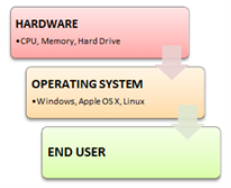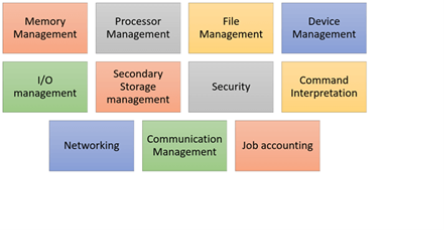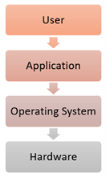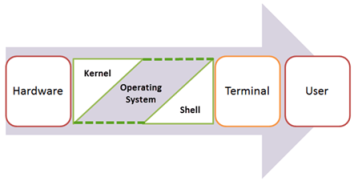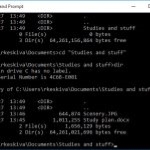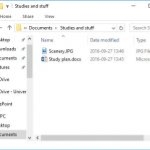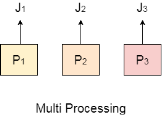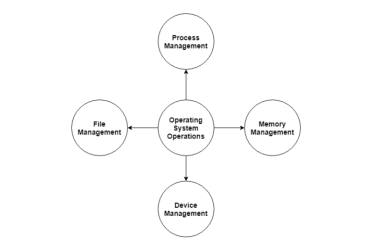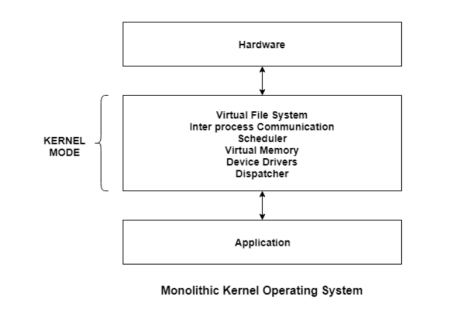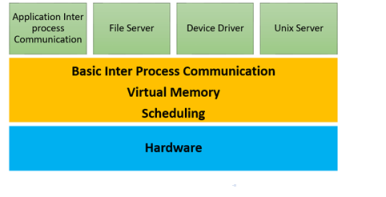UNIT 1
Overview of OS
An Operating System (OS) is software that acts as an interface between computer hardware components and the user. Every computer system must have at least one operating system to run other programs. Applications like Browsers, MS Office, Notepad Games, etc., need some environment to run and perform its tasks.
The OS helps you to communicate with the computer without knowing how to speak the computer's language. It is not possible for the user to use any computer or mobile device without having an operating system.
|
Fig 1 - Introduction to Operating System
- Operating systems were first developed in the late 1950s to manage tape storage
- The General Motors Research Lab implemented the first OS in the early 1950s for their IBM 701
- In the mid-1960s, operating systems started to use disks
- In the late 1960s, the first version of the Unix OS was developed
- The first OS built by Microsoft was DOS. It was built in 1981 by purchasing the 86-DOS software from a Seattle company
- The present-day popular OS Windows first came to existence in 1985 when a GUI was created and paired with MS-DOS.
Types of Operating System (OS)
Following are the popular types of Operating System:
- Batch Operating System
- Multitasking/Time Sharing OS
- Multiprocessing OS
- Real Time OS
- Distributed OS
- Network OS
- Mobile OS
Some computer processes are very lengthy and time-consuming. To speed the same process, a job with a similar type of needs are batched together and run as a group.
The user of a batch operating system never directly interacts with the computer. In this type of OS, every user prepares his or her job on an offline device like a punch card and submit it to the computer operator.
Multi-Tasking/Time-sharing Operating systems
Time-sharing operating system enables people located at a different terminal(shell) to use a single computer system at the same time. The processor time (CPU) which is shared among multiple users is termed as time sharing.
A real time operating system time interval to process and respond to inputs is very small. Examples: Military Software Systems, Space Software Systems are the Real time OS example.
Distributed systems use many processors located in different machines to provide very fast computation to its users.
Network Operating System runs on a server. It provides the capability to serve to manage data, user, groups, security, application, and other networking functions.
Mobile operating systems are those OS which is especially that are designed to power smartphones, tablets, and wearables devices.
Some most famous mobile operating systems are Android and iOS, but others include BlackBerry, Web, and watchOS.
Below are the main functions of Operating System:
|
Fig 2 - Functions of Operating System
In an operating system software performs each of the function:
- Process management: - Process management helps OS to create and delete processes. It also provides mechanisms for synchronization and communication among processes.
2. Memory management: - Memory management module performs the task of allocation and de-allocation of memory space to programs in need of this resources.
3. File management: - It manages all the file-related activities such as organization storage, retrieval, naming, sharing, and protection of files.
4. Device Management: Device management keeps tracks of all devices. This module also responsible for this task is known as the I/O controller. It also performs the task of allocation and de-allocation of the devices.
5. I/O System Management: One of the main objects of any OS is to hide the peculiarities of that hardware devices from the user.
6. Secondary-Storage Management: Systems have several levels of storage which includes primary storage, secondary storage, and cache storage. Instructions and data must be stored in primary storage or cache so that a running program can reference it.
7. Security: - Security module protects the data and information of a computer system against malware threat and authorized access.
8. Command interpretation: This module is interpreting commands given by the and acting system resources to process that commands.
9. Networking: A distributed system is a group of processors which do not share memory, hardware devices, or a clock. The processors communicate with one another through the network.
10. Job accounting: Keeping track of time & resource used by various job and users.
11. Communication management: Coordination and assignment of compilers, interpreters, and another software resource of the various users of the computer systems.
Features of Operating System (OS)
Here is a list important features of OS:
- Protected and supervisor mode
- Allows disk access and file systems Device drivers Networking Security
- Program Execution
- Memory management Virtual Memory Multitasking
- Handling I/O operations
- Manipulation of the file system
- Error Detection and handling
- Resource allocation
- Information and Resource Protection
|
Fig 3 - Features
Advantage of using Operating System
- Allows you to hide details of hardware by creating an abstraction
- Easy to use with a GUI
- Offers an environment in which a user may execute programs/applications
- The operating system must make sure that the computer system convenient to use
- Operating System acts as an intermediary among applications and the hardware components
- It provides the computer system resources with easy to use format
- Acts as an intermediator between all hardware's and software's of the system
Disadvantages of using Operating System
- If any issue occurs in OS, you may lose all the contents which have been stored in your system
- Operating system's software is quite expensive for small size organization which adds burden on them. Example Windows
- It is never entirely secure as a threat can occur at any time
The kernel is the central component of a computer operating systems. The only job performed by the kernel is to the manage the communication between the software and the hardware. A Kernel is at the nucleus of a computer. It makes the communication between the hardware and software possible. While the Kernel is the innermost part of an operating system, a shell is the outermost one.
|
Fig 4 - Introduction to Kernel
- Low-level scheduling of processes
- Inter-process communication
- Process synchronization
- Context switching
There are many types of kernels that exists, but among them, the two most popular kernels are:
1.Monolithic
A monolithic kernel is a single code or block of the program. It provides all the required services offered by the operating system. It is a simplistic design which creates a distinct communication layer between the hardware and software.
2. Microkernels
Microkernel manages all system resources. In this type of kernel, services are implemented in different address space. The user services are stored in user address space, and kernel services are stored under kernel address space. So, it helps to reduce the size of both the kernel and operating system.
Difference between Firmware and Operating System
Firmware | Operating System |
Firmware is one kind of programming that is embedded on a chip in the device which controls that specific device. | OS provides functionality over and above that which is provided by the firmware. |
Firmware is programs that been encoded by the manufacture of the IC or something and cannot be changed | OS is a program that can be installed by the user and can be changed. |
It is stored on non-volatile memory. | OS is stored on the hard drive. |
Difference between 32-Bit vs. 64 Bit Operating System
Parameters | 32. Bit | 64. Bit |
Architecture and Software | Allow 32 bit of data processing simultaneously | Allow 64 bit of data processing simultaneously |
Compatibility | 32-bit applications require 32-bit OS and CPUs | 64-bit applications require a 64-bit OS and CPU. |
Systems Available | All versions of Windows 8, Windows 7, Windows Vista, and Windows XP, Linux, etc. | Windows XP Professional, Vista, 7, Mac OS X and Linux. |
Memory Limits | 32-bit systems are limited to 3.2 GB of RAM. | 64-bit systems allow a maximum 17 Billion GB of RAM. |
- Define Operating System: An operating system is a software which acts as an interface between the end user and computer hardware
- Operating systems were first developed in the late 1950s to manage tape storage
- The kernel is the central component of a computer operating systems. The only job performed by the kernel is to the manage the communication between the software and the hardware
- Two most popular kernels are Monolithic and MicroKernels
- Process, Device, File, I/O, Secondary-Storage, Memory management are various functions of an Operating System
- Batch, Multitasking/Time Sharing, Multiprocessing, Real Time, Distributed, Network, Mobile are various types of OS
Key takeaway
An Operating System (OS) is a software that acts as an interface between computer hardware components and the user. Every computer system must have at least one operating system to run other programs. Applications like Browsers, MS Office, Notepad Games, etc., need some environment to run and perform its tasks.
The OS helps you to communicate with the computer without knowing how to speak the computer's language. It is not possible for the user to use any computer or mobile device without having an operating system.
Operating system and user interface
As already mentioned, in addition to the hardware, a computer also needs a set of programs—an operating system—to control the devices. This page will discuss the following:
- There are different kinds of operating systems: such as Windows, Linux and Mac OS
- There are also different versions of these operating systems, e.g. Windows 7, 8 and 10
- Operating systems can be used with different user interfaces (UI): text user interfaces (TUI) and graphical user interfaces (GUI) as examples
- Graphical user interfaces have many similarities in different operating systems: such as the start menu, desktop etc.
When you can recognize the typical parts of each operating system’s user interface, you will mostly be able to use both Windows and Linux as well as e.g. Mac OS.
The role of operating system in the computer
An operating system (OS) is a set of programs which ensures the interoperability of the hardware and software in your computer. The operating system enables, among other things,
- the identification and activation of devices connected to the computer,
- the installation and use of programs, and
- the handling of files.
What happens when you turn on your computer or smartphone?
– The computer checks the functionality of its components and any devices connected to it, and starts to look for the OS on a hard drive or other memory media.
– If the OS is found, the computer starts to load it into the RAM (Random Access Memory).
– When the OS has loaded, the computer waits for commands from you.
Over the years, several different operating systems have been developed for different purposes. The most typical operating systems in ordinary computers are Windows, Linux and Mac OS.
The name of the Windows OS comes from the fact that programs are run in “windows”: each program has its own window, and you can have several programs open at the same time. Windows is the most popular OS for home computers, and there are several versions of it. The newest version is Windows 10.
Linux is an open-source OS, which means that its program code is freely available to software developers. This is why thousands of programmers around the world have developed Linux, and it is considered the most tested OS in the world. Linux has been very much influenced by the commercial Unix OS.
In addition to servers, Linux is widely used in home computers, since there are a great number of free programs for it (for text and image processing, spreadsheets, publishing, etc.). Over the years, many different versions of Linux have become available for distribution, most of which are free for the user (such as Ubuntu, Fedora and Mint, to name a few). See the additional reading material for more information on Linux.
Apple’s Mac computers have their own operating system, OS X. Most of the programs that are available for PCs are also available for Macs running under OS X, but these two types of computers cannot use the exact same programs: for example, you cannot install the Mac version of the Microsoft Office suite on a Windows computer. You can install other operating systems on Mac computers, but the OS X is only available for computers made by Apple. Apple’s lighter portable devices (iPads, iPhones) use a light version of the same operating system, called iOS.
Mac computers are popular because OS X is considered fast, easy to learn and very stable and Apple’s devices are considered well-designed—though rather expensive. See the additional reading material for more information on OS X.
Android is an operating system designed for phones and other mobile devices. Android is not available for desktop computers, but in mobile devices it is extremely popular: more than a half of all mobile devices in the world run on Android.
A user interface (UI) refers to the part of an operating system, program, or device that allows a user to enter and receive information. A text-based user interface (see the image to the left) displays text, and its commands are usually typed on a command line using a keyboard. With a graphical user interface (see the right-hand image), the functions are carried out by clicking or moving buttons, icons and menus by means of a pointing device.
Fig 5 - Larger image: text UI | graphical UI
The images contain the same information: a directory listing of a computer. You can often carry out the same tasks regardless of which kind of UI you are using.
Modern graphical user interfaces have evolved from text-based UIs. Some operating systems can still be used with a text-based user interface. In this case, the commands are entered as text (e.g., “cat story.txt”).
To display the text-based Command Prompt in Windows, open the Start menu and type cmd. Press Enter on the keyboard to launch the command prompt in a separate window. With the command prompt, you can type your commands from the keyboard instead of using the mouse.
In most operating systems, the primary user interface is graphical, i.e. instead of typing the commands you manipulate various graphical objects (such as icons) with a pointing device. The underlying principle of different graphical user interfaces (GUIs) is largely the same, so by knowing how to use a Windows UI, you will most likely know how to use Linux or some other GUI.
Most GUIs have the following basic components:
- a start menu with program groups
- a taskbar showing running programs
- a desktop
- Various icons and shortcuts.
Key takeaway
As already mentioned, in addition to the hardware, a computer also needs a set of programs—an operating system—to control the devices. This page will discuss the following:
- There are different kinds of operating systems: such as Windows, Linux and Mac OS
- There are also different versions of these operating systems, e.g. Windows 7, 8 and 10
- Operating systems can be used with different user interfaces (UI): text user interfaces (TUI) and graphical user interfaces (GUI) as examples
- Graphical user interfaces have many similarities in different operating systems: such as the start menu, desktop etc.
Operating systems are there from the very first computer generation and they keep evolving with time. In this chapter, we will discuss some of the important types of operating systems which are most commonly used.
The users of a batch operating system do not interact with the computer directly. Each user prepares his job on an off-line device like punch cards and submits it to the computer operator. To speed up processing, jobs with similar needs are batched together and run as a group. The programmers leave their programs with the operator and the operator then sorts the programs with similar requirements into batches.
The problems with Batch Systems are as follows −
- Lack of interaction between the user and the job.
- CPU is often idle, because the speed of the mechanical I/O devices is slower than the CPU.
- Difficult to provide the desired priority.
Multiprogramming Operating System
Multiprogramming is an extension to the batch processing where the CPU is kept always busy. Each process needs two types of system time: CPU time and IO time.
In multiprogramming environment, for the time a process does its I/O, The CPU can start the execution of other processes. Therefore, multiprogramming improves the efficiency of the system.
Multiprocessing Operating System
In Multiprocessing, Parallel computing is achieved. There are more than one processors present in the system which can execute more than one process at the same time. This will increase the throughput of the system.
|
Fig 6 – Multi processing
Time-sharing operating systems
Time-sharing is a technique which enables many people, located at various terminals, to use a particular computer system at the same time. Time-sharing or multitasking is a logical extension of multiprogramming. Processor's time which is shared among multiple users simultaneously is termed as time-sharing.
The main difference between Multiprogrammed Batch Systems and Time-Sharing Systems is that in case of Multiprogrammed batch systems, the objective is to maximize processor use, whereas in Time-Sharing Systems, the objective is to minimize response time.
Multiple jobs are executed by the CPU by switching between them, but the switches occur so frequently. Thus, the user can receive an immediate response. For example, in a transaction processing, the processor executes each user program in a short burst or quantum of computation. That is, if n users are present, then each user can get a time quantum. When the user submits the command, the response time is in few seconds at most.
The operating system uses CPU scheduling and multiprogramming to provide each user with a small portion of a time. Computer systems that were designed primarily as batch systems have been modified to time-sharing systems.
Advantages of Timesharing operating systems are as follows −
- Provides the advantage of quick response.
- Avoids duplication of software.
- Reduces CPU idle time.
Disadvantages of Time-sharing operating systems are as follows −
- Problem of reliability.
- Question of security and integrity of user programs and data.
- Problem of data communication.
Distributed systems use multiple central processors to serve multiple real-time applications and multiple users. Data processing jobs are distributed among the processors accordingly.
The processors communicate with one another through various communication lines (such as high-speed buses or telephone lines). These are referred as loosely coupled systems or distributed systems. Processors in a distributed system may vary in size and function. These processors are referred as sites, nodes, computers, and so on.
The advantages of distributed systems are as follows −
- With resource sharing facility, a user at one site may be able to use the resources available at another.
- Speedup the exchange of data with one another via electronic mail.
- If one site fails in a distributed system, the remaining sites can potentially continue operating.
- Better service to the customers.
- Reduction of the load on the host computer.
- Reduction of delays in data processing.
A Network Operating System runs on a server and provides the server the capability to manage data, users, groups, security, applications, and other networking functions. The primary purpose of the network operating system is to allow shared file and printer access among multiple computers in a network, typically a local area network (LAN), a private network or to other networks.
Examples of network operating systems include Microsoft Windows Server 2003, Microsoft Windows Server 2008, UNIX, Linux, Mac OS X, Novell NetWare, and BSD.
The advantages of network operating systems are as follows −
- Centralized servers are highly stable.
- Security is server managed.
- Upgrades to new technologies and hardware can be easily integrated into the system.
- Remote access to servers is possible from different locations and types of systems.
The disadvantages of network operating systems are as follows −
- High cost of buying and running a server.
- Dependency on a central location for most operations.
- Regular maintenance and updates are required.
A real-time system is defined as a data processing system in which the time interval required to process and respond to inputs is so small that it controls the environment. The time taken by the system to respond to an input and display of required updated information is termed as the response time. So in this method, the response time is very less as compared to online processing.
Real-time systems are used when there are rigid time requirements on the operation of a processor or the flow of data and real-time systems can be used as a control device in a dedicated application. A real-time operating system must have well-defined, fixed time constraints, otherwise the system will fail. For example, Scientific experiments, medical imaging systems, industrial control systems, weapon systems, robots, air traffic control systems, etc.
There are two types of real-time operating systems.
Hard real-time systems guarantee that critical tasks complete on time. In hard real-time systems, secondary storage is limited or missing and the data is stored in ROM. In these systems, virtual memory is almost never found.
Soft real-time systems are less restrictive. A critical real-time task gets priority over other tasks and retains the priority until it completes. Soft real-time systems have limited utility than hard real-time systems. For example, multimedia, virtual reality, Advanced Scientific Projects like undersea exploration and planetary rovers, etc.
Key takeaway
The users of a batch operating system do not interact with the computer directly. Each user prepares his job on an off-line device like punch cards and submits it to the computer operator. To speed up processing, jobs with similar needs are batched together and run as a group. The programmers leave their programs with the operator and the operator then sorts the programs with similar requirements into batches.
An operating system is a construct that allows the user application programs to interact with the system hardware. Operating system by itself does not provide any function but it provides an atmosphere in which different applications and programs can do useful work.
The major operations of the operating system are process management, memory management, device management and file management. These are given in detail as follows:
|
Fig 7 – OS Operations
The operating system is responsible for managing the processes i.e. assigning the processor to a process at a time. This is known as process scheduling. The different algorithms used for process scheduling are FCFS (first come first served), SJF (shortest job first), priority scheduling, round robin scheduling etc.
There are many scheduling queues that are used to handle processes in process management. When the processes enter the system, they are put into the job queue. The processes that are ready to execute in the main memory are kept in the ready queue. The processes that are waiting for the I/O device are kept in the device queue.
Memory management plays an important part in operating system. It deals with memory and the moving of processes from disk to primary memory for execution and back again.
The activities performed by the operating system for memory management are −
- The operating system assigns memory to the processes as required. This can be done using best fit, first fit and worst fit algorithms.
- All the memory is tracked by the operating system i.e. it nodes what memory parts are in use by the processes and which are empty.
- The operating system deallocated memory from processes as required. This may happen when a process has been terminated or if it no longer needs the memory.
There are many I/O devices handled by the operating system such as mouse, keyboard, disk drive etc. There are different device drivers that can be connected to the operating system to handle a specific device. The device controller is an interface between the device and the device driver. The user applications can access all the I/O devices using the device drivers, which are device specific codes.
Files are used to provide a uniform view of data storage by the operating system. All the files are mapped onto physical devices that are usually non-volatile so data is safe in the case of system failure.
The files can be accessed by the system in two ways i.e. sequential access and direct access −
- Sequential Access
The information in a file is processed in order using sequential access. The files records are accessed on after another. Most of the file systems such as editors, compilers etc. use sequential access.
- Direct Access
In direct access or relative access, the files can be accessed in random for read and write operations. The direct access model is based on the disk model of a file, since it allows random accesses.
Key takeaway
An operating system is a construct that allows the user application programs to interact with the system hardware. Operating system by itself does not provide any function but it provides an atmosphere in which different applications and programs can do useful work.
The major operations of the operating system are process management, memory management, device management and file management.
The entire operating system works in the kernel space in the monolithic system. This increases the size of the kernel as well as the operating system. This is different than the microkernel system where the minimum software that is required to correctly implement an operating system is kept in the kernel.
A diagram that demonstrates the architecture of a monolithic system is as follows −
|
Fig 8 – Monolithic kernel OS
The kernel provides various services such as memory management, file management, process scheduling etc. using function calls. This makes the execution of the operating system quite fast as the services are implemented under the same address space.
Differences between Microkernel and Monolithic Kernel
Some of the differences between microkernel and monolithic kernel are given as follows −
- The microkernel is much smaller in size as compared to the monolithic kernel.
- The microkernel is easily extensible whereas this is quite complicated for the monolithic kernel.
- The execution of the microkernel is slower as compared to the monolithic kernel.
- Much more code is required to write a microkernel than the monolithic kernel.
- Examples of Microkernel are QNX, Symbian, L4 Linux etc. Monolithic Kernel examples are Linux, BSD etc.
Advantages of Monolithic Kernel
Some of the advantages of monolithic kernel are −
- The execution of the monolithic kernel is quite fast as the services such as memory management, file management, process scheduling etc.are implemented under the same address space.
- A process runs completely in a single address space in the monolithic kernel.
- The monolithic kernel is a static single binary file.
Disadvantages of Monolithic Kernel
Some of the disadvantages of monolithic kernel are −
- If any service fails in the monolithic kernel, it leads to the failure of the entire system.
- To add any new service, the entire operating system needs to be modified by the user.
Key takeaway
The entire operating system works in the kernel space in the monolithic system. This increases the size of the kernel as well as the operating system. This is different than the microkernel system where the minimum software that is required to correctly implement an operating system is kept in the kernel.
Virtual Machine abstracts the hardware of our personal computer such as CPU, disk drives, memory, NIC (Network Interface Card) etc, into many different execution environments as per our requirements, hence giving us a feel that each execution environment is a single computer. For example, VirtualBox.
When we run different processes on an operating system, it creates an illusion that each process is running on a different processor having its own virtual memory, with the help of CPU scheduling and virtual-memory techniques. There are additional features of a process that cannot be provided by the hardware alone like system calls and a file system. The virtual machine approach does not provide these additional functionalities but it only provides an interface that is same as basic hardware. Each process is provided with a virtual copy of the underlying computer system.
We can create a virtual machine for several reasons, all of which are fundamentally related to the ability to share the same basic hardware yet can also support different execution environments, i.e., different operating systems simultaneously.
The main drawback with the virtual-machine approach involves disk systems. Let us suppose that the physical machine has only three disk drives but wants to support seven virtual machines. Obviously, it cannot allocate a disk drive to each virtual machine, because virtual-machine software itself will need substantial disk space to provide virtual memory and spooling. The solution is to provide virtual disks.
Users are thus given their own virtual machines. After which they can run any of the operating systems or software packages that are available on the underlying machine. The virtual-machine software is concerned with multi-programming multiple virtual machines onto a physical machine, but it does not need to consider any user-support software. This arrangement can provide a useful way to divide the problem of designing a multi-user interactive system, into two smaller pieces.
Advantages:
- There are no protection problems because each virtual machine is completely isolated from all other virtual machines.
- Virtual machine can provide an instruction set architecture that differs from real computers.
- Easy maintenance, availability and convenient recovery.
Disadvantages:
- When multiple virtual machines are simultaneously running on a host computer, one virtual machine can be affected by other running virtual machines, depending on the workload.
- Virtual machines are not as efficient as a real one when accessing the hardware.
Key takeaway
Virtual Machine abstracts the hardware of our personal computer such as CPU, disk drives, memory, NIC (Network Interface Card) etc, into many different execution environments as per our requirements, hence giving us a feel that each execution environment is a single computer. For example, VirtualBox.
When we run different processes on an operating system, it creates an illusion that each process is running on a different processor having its own virtual memory, with the help of CPU scheduling and virtual-memory techniques. There are additional features of a process that cannot be provided by the hardware alone like system calls and a file system. The virtual machine approach does not provide these additional functionalities but it only provides an interface that is same as basic hardware. Each process is provided with a virtual copy of the underlying computer system.
A kernel is an important part of an OS that manages system resources. It also acts as a bridge between the software and hardware of the computer. It is one of the first program which is loaded on start-up after the bootloader. The Kernel is also responsible for offering secure access to the machine's hardware for various programs. It also decides when and how long a certain application uses specific hardware.
Microkernel is a software or code which contains the required minimum amount of functions, data, and features to implement an operating system. It provides a minimal number of mechanisms, which is good enough to run the most basic functions of an operating system. It allows other parts of the operating system to be implemented as it does not impose a lot of policies.
Microkernels and their user environments are usually implemented in the C++ or C programming languages with a little bit of assembly. However, other implementation languages are possible with some high-level coding.
Monolithic Kernel runs all the basic system services like process management, Memory management, I/O communication, and interrupt handling, file system, etc in kernel space.
In this type of Kernel approach, the entire operating system runs as a single program in kernel mode. The operating system is written as a collection of procedures that are linked together into a large executable binary program.
A Microkernel is the most important part for correct implementation of an operating system. You can see in the below-given diagram, that Microkernel fulfills basic operations like memory, process scheduling mechanisms, and inter-process communication.
|
Fig 9 - Microkernel Based Operating System
Microkernel is the only software executing at the privileged level. The other important functionalities of the OS are removed from the kernel-mode and run in the user mode. These functionalities may be device drivers, application, file servers, interposes communication, etc.
A microkernel comprises only the core functionalities of the system. A component is included in the Microkernel only if putting it outside would interrupt the functionality of the system. All other non-essential components should be put in the user mode.
The minimum functionalities required in the Microkernel are:
- Memory management mechanisms like address spaces should be included in the Microkernel. It also contains memory protection features.
- Processor scheduling mechanisms should contain process and thread schedulers.
- Inter-process communication manages the servers that run their own address spaces.
Difference Between Microkernel and Monolithic Kernel
Parameters | Monolithic kernel | MicroKernel |
Basic | It is a large process running in a single address space | It can be broken down into separate processes called servers. |
Code | In order to write a monolithic kernel, less code is required. | In order to write a microkernel, more code is required |
Security | If a service crashes, the whole system collapses in a monolithic kernel. | If a service crashes, it never affects the working of a microkernel. |
Communication | It is a single static binary file | Servers communicate through IPC. |
Example | Linux, BSDs, Microsoft Windows (95,98, Me), Solaris, OS-9, AIX, DOS, XTS-400, etc. | L4Linux, QNX, SymbianK42, Mac OS X, Integrity, etc. |
Here, are the pros/benefits of using Microkernel
- Microkernel architecture is small and isolated therefore it can function better.
- Microkernels are secure because only those components are included that disrupt the functionality of the system otherwise.
- The expansion of the system is more accessible, so it can be added to the system application without disturbing the Kernel.
- Microkernels are modular, and the different modules can be replaced, reloaded, modified without even touching the Kernel.
- Fewer system crashes when compared with monolithic systems.
- Microkernel interface helps you to enforce a more modular system structure.
- Without recompiling, add new features
- Server malfunction is also isolated as any other user program's malfunction.
- Microkernel system is flexible, so different strategies and APIs, implemented by different servers, which can coexist in the system.
- Increased security and stability will result in a decreased amount of code which runs on kernel mode
Here, are drawback/cons of using Microkernel:
- Providing services in a microkernel system are expensive compared to the normal monolithic system.
- Context switch or a function call needed when the drivers are implemented as procedures or processes, respectively.
- The performance of a microkernel system can be indifferent and may lead to some problems.
- A kernel is an important part of an OS that manages system resources.
- A microkernel is a software or code which contains the required minimum amount of functions, data, and features to implement an operating system.
- In Monolithic Kernel approach, the entire operating system runs as a single program in kernel mode
- A Microkernel is the most important part for correct implementation of an operating system.
- A microkernel comprises only the core functionalities of the system.
- A monolithic kernel is a large process running in a single address space, whereas Microkernel can be broken down into separate processes called servers.
- Microkernel architecture is small and isolated therefore it can function better
- Providing services in a microkernel system are expensive compared to the normal monolithic system
Key takeaway
A kernel is an important part of an OS that manages system resources. It also acts as a bridge between the software and hardware of the computer. It is one of the first program which is loaded on start-up after the bootloader. The Kernel is also responsible for offering secure access to the machine's hardware for various programs. It also decides when and how long a certain application uses specific hardware.
Microkernel is a software or code which contains the required minimum amount of functions, data, and features to implement an operating system. It provides a minimal number of mechanisms, which is good enough to run the most basic functions of an operating system. It allows other parts of the operating system to be implemented as it does not impose a lot of policies.
Microkernels and their user environments are usually implemented in the C++ or C programming languages with a little bit of assembly. However, other implementation languages are possible with some high-level coding.
Monolithic Kernel runs all the basic system services like process management, Memory management, I/O communication, and interrupt handling, file system, etc in kernel space.
In this type of Kernel approach, the entire operating system runs as a single program in kernel mode. The operating system is written as a collection of procedures that are linked together into a large executable binary program.
References:
1. Operating Systems –A Concept Based approach –Dhananjay M Dhamdhere (TMGH).3rdedition.
2. Operating System Concepts –Abraham Silberschatz, Peter B. Galvin &Grege Gagne(Wiley)
3. UNIX Concepts and Applications –Sumitabha Das(TMGH).
4. Operating System: Concepts and Design –Milan Milenkovic (TMGH)
5. Operating System with case studies in Unix, Netware and Windows NT –Achyut S. Godbole (TMGH).
